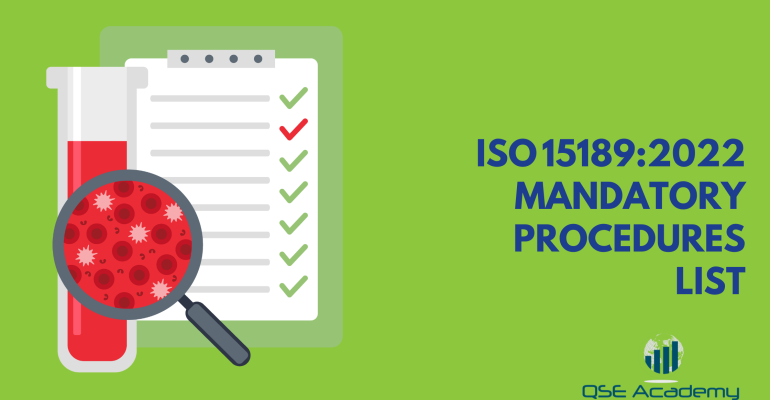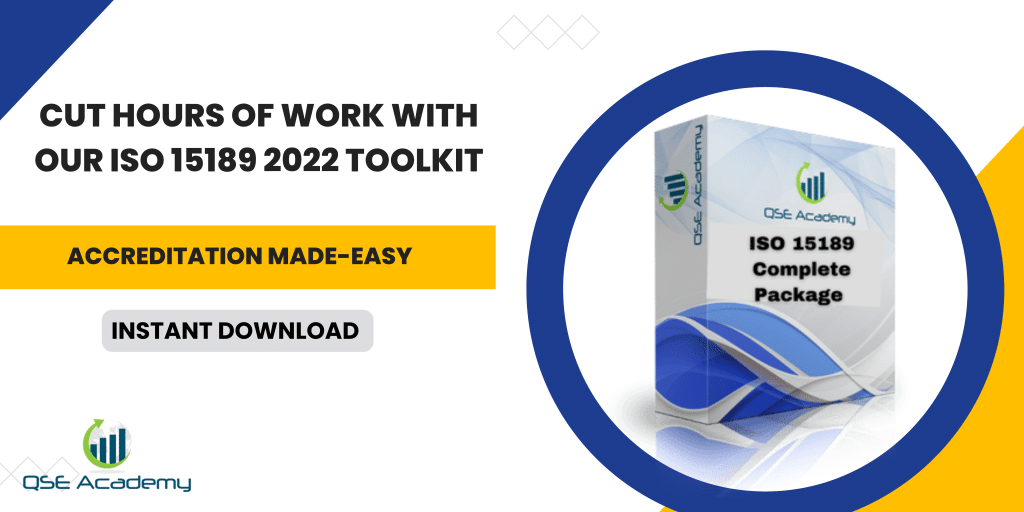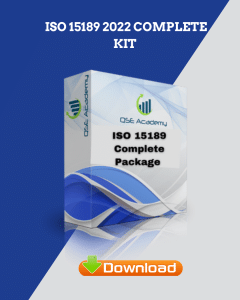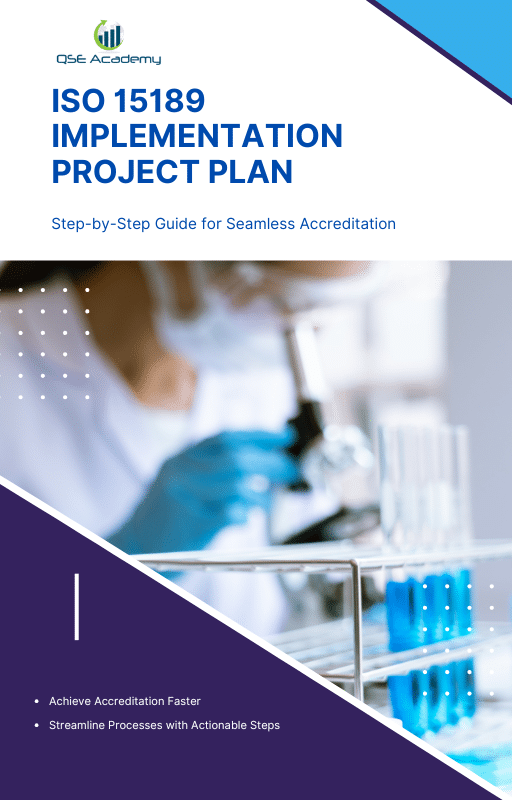ISO 15189:2022 Mandatory Procedures List
Last Updated on October 22, 2025 by Hafsa J.
Understanding the Mandatory Procedures in ISO 15189:2022
Every time a lab calls me panicked after failing an ISO 15189 audit, the story sounds familiar. They’ve done the hard work—calibration, training, even internal audits—but what tripped them up was missing or poorly written mandatory procedures.
Here’s what I’ve noticed: labs often confuse records with procedures. Records prove that something happened; procedures explain how it’s supposed to happen. Without those “how-to” documents, auditors can’t see your consistency or competence.
In this guide, I’ll walk you through:
-
Which procedures are explicitly required in ISO 15189:2022.
-
How to build them without drowning in paperwork.
-
A few pro tips that’ll help you impress assessors on the first try.
If you’re building or upgrading your lab’s management system, this is the checklist you’ll want open on your desk.
Understanding “Mandatory Procedures” in ISO 15189:2022
Here’s something I see all the time: labs think ISO 15189 comes with a ready-made checklist of procedures to copy. It doesn’t.
The 2022 version actually moved away from the rigid “you must have this document” mindset. Instead, it tells you to document where it’s necessary to ensure consistency and competence.
So what does that mean in practice?
If an activity affects quality, reliability, or traceability of results — you need a documented procedure for it. That’s what auditors will look for.
Think of it like this:
If your staff can perform a process exactly the same way tomorrow — even if you’re not there — that’s a sign your procedure is clear enough.
Pro Tip:
When the standard says “the laboratory shall establish and maintain a procedure,” that’s your signal it’s mandatory. Don’t overthink it — highlight those sentences in your copy of the standard and build your list from there.
Common Pitfall:
Many teams confuse records with procedures.
A record is proof that something happened.
A procedure explains how it’s supposed to happen.
If you only have records but no written procedure, your system looks reactive instead of controlled.
Example:
I worked with a molecular diagnostics lab that had tons of training records but no documented “Competence Evaluation Procedure.”
During accreditation, the assessor asked, “How do you define and maintain competence?”
They pointed to their training certificates.
That’s when it hit them — certificates don’t show how competence is assessed.
The takeaway?
Don’t rely on evidence alone. Show the method behind it — that’s what ISO 15189:2022 calls a mandatory procedure.
Quality Management System Procedures (Clause 8 – Management System Requirements)
When you look at ISO 15189’s structure, Clause 8 is where most of the classic “must-have” procedures live. These are the backbone of your laboratory’s quality management system. Without them, everything else feels improvised — and that’s exactly what assessors pick up on.
Here’s what every accredited lab I’ve worked with keeps airtight under Clause 8:
| Clause | Procedure Title | Purpose / Why It Matters |
|---|---|---|
| 8.3 | Document Control Procedure | Defines how documents are created, reviewed, approved, and updated so everyone works from the same version. |
| 8.4 | Record Control Procedure | Explains how records are stored, protected, and retrieved — a lifesaver when auditors ask for a calibration log from six months ago. |
| 8.6 | Internal Audit Procedure | Outlines how audits are planned, performed, and followed up. This is where you prove you’re not just compliant, but self-correcting. |
| 8.7 | Corrective Action Procedure | Shows how you identify root causes, implement fixes, and verify their effectiveness. Auditors love clear logic here. |
| 8.9 | Management Review Procedure | Describes how leadership evaluates performance data, risks, and opportunities — ensuring improvement doesn’t get lost in the daily rush. |
Pro Tip:
Keep your document and record control procedures short and visual — use flowcharts or checklists. Assessors appreciate clarity over length. A two-page visual guide often works better than a ten-page narrative.
Common Mistake:
Labs often store audit results and management review minutes but forget to define how those activities are actually done. Remember: a record without a corresponding procedure raises red flags.
In my experience:
One regional pathology lab I helped had strong technical competence but failed its first audit because their “Corrective Action” process wasn’t defined. Once we wrote a simple, three-step flow (Identify → Investigate → Implement), they passed the re-audit with zero non-conformities.
Bottom line:
Clause 8 procedures aren’t optional paperwork — they’re what demonstrate control, accountability, and continuous improvement in action.
Technical & Operational Procedures (Clause 7 – Process Requirements)
Clause 7 is where your lab’s day-to-day operations meet compliance. It’s the heart of ISO 15189:2022 — everything from how samples arrive to how results are reported. If these processes aren’t written down clearly, consistency goes out the window fast.
Here’s how I usually break them down when guiding a new client:
Pre-Examination Procedures
These cover what happens before testing even begins — think sample collection, transport, and acceptance.
Your Specimen Collection and Transport Procedure should explain who collects samples, what containers are used, temperature limits, and rejection criteria.
That single document often eliminates 80 % of disputes between departments.
Pro Tip:
Write it for the people who actually do the work. Avoid technical jargon if your phlebotomists or couriers won’t understand it.
Examination Procedures
This is where you define how tests are validated, verified, and performed.
Include procedures for Method Validation, Equipment Calibration, and Measurement Uncertainty — all hot-button items in assessments.
Pitfall:
Relying solely on manufacturer manuals. Those describe how the instrument works, not how your lab performs the test. ISO 15189 requires a laboratory-specific procedure that integrates your workflow, controls, and acceptance limits.
Example:
One clinical chemistry lab I worked with failed to document its internal QC review process. Adding a one-page “Review of QC Data Procedure” not only fixed the issue but also improved trend detection.
Post-Examination Procedures
After analysis, results need to be authorized, reviewed, and communicated correctly.
Procedures here include Result Verification, Report Issuance, and Communication of Critical Results.
Assessors often ask to see who has the authority to release reports — make that explicit.
Pro Tip:
Add a “Release Authority Matrix” as an annex to your procedure. It keeps things crystal clear and saves explanations during audits.
Nonconforming Work Procedure
Mistakes happen — but how you handle them determines your lab’s credibility.
Your Nonconforming Work Procedure should define how issues are identified, evaluated for impact, and documented for corrective action.
In my experience:
Labs that treat nonconformities as learning tools, not punishments, improve faster and maintain trust internally.
Resource & Personnel Procedures (Clause 6 – Resource Requirements)
Every successful lab I’ve worked with has one thing in common — they don’t treat people and equipment as “resources” on paper. They treat them as the foundation of their competence. Clause 6 of ISO 15189:2022 makes that clear.
Your lab’s credibility depends on the competence of its personnel, the reliability of its equipment, and the stability of its environment. That’s why these procedures are mandatory — they prove you’ve built a system that supports consistent, valid results.
Personnel Competence and Training Procedure
You need to define exactly how staff are selected, trained, and authorized to perform specific tasks.
Include job descriptions, required qualifications, and competence evaluation criteria.
Pro Tip:
Keep competence assessments simple but measurable — for example, direct observation, proficiency testing, or result reviews. Make it easy for assessors to see your logic.
Common Mistake:
Relying on certificates alone. A degree shows knowledge, not competence. ISO 15189 wants evidence that staff can consistently perform the assigned task.
Equipment Calibration and Maintenance Procedure
This one’s non-negotiable. Every instrument must have a defined process for calibration, verification, and preventive maintenance.
Example:
A microbiology lab I helped once failed an audit because their “maintenance” logs were vendor invoices. We implemented a simple monthly equipment checklist — problem solved.
Pro Tip:
Create a single “Equipment Control Matrix” that lists calibration dates, responsible persons, and due dates. It’s a lifesaver during audits.
Supplier Evaluation and Outsourced Services Procedure
Clause 6 also expects control over what you buy and outsource. That includes reagents, calibrators, and even external testing.
Define how suppliers are selected, evaluated, and re-approved.
Pitfall:
Labs often skip re-evaluation. It’s not one-and-done — ISO 15189 wants ongoing assurance that your suppliers remain reliable.
Environmental Monitoring Procedure
From temperature to humidity to biosafety controls — define how you monitor and record conditions that could affect results.
Pro Tip:
Automate where possible, but don’t rely solely on sensors. Have a backup manual check and alarm system documented.
Risk Management and Improvement Procedures (Clauses 8.5 & 8.8)
Here’s something I always remind labs of — ISO 15189 isn’t just about running tests correctly. It’s about managing uncertainty and continually improving how you work. Clauses 8.5 and 8.8 are where that philosophy becomes procedure.
You’re expected to have clear, written methods for how you identify risks, handle problems, and drive improvement. These aren’t theoretical exercises. They’re living processes that shape your lab’s decisions every day.
Risk Management and Opportunity Assessment Procedure
This procedure defines how you identify, assess, and control risks that could affect quality.
Pro Tip:
Use a simple risk matrix. Rank risks by likelihood and impact — high, medium, low. Don’t overcomplicate it with fancy software unless you really need it.
Example:
One genetics lab I worked with tracked its biggest risk — sample mislabeling — in a weekly team huddle. That single change cut labeling errors by 30 % in two months.
Common Mistake:
Filing risk assessments away after the audit. Risks should be reviewed continuously, especially when procedures or equipment change.
Control of Nonconforming Work Procedure
This one connects your risk management and corrective action systems. It’s about what happens when something goes wrong — a test repeated, a report recalled, or equipment found out of tolerance.
Define who investigates, how impact is assessed, and what happens to affected results.
Pro Tip:
Add a quick decision flow: Stop → Contain → Correct → Record. It helps staff act fast without guessing.
Improvement and Corrective Action Procedure
Clause 8.8 pushes you to go beyond fixing mistakes — it wants proof you’re improving over time.
Include steps for identifying improvement opportunities from audits, feedback, and data analysis. Even small wins count — reduced turnaround time, better sample tracking, or fewer QC alerts.
In my experience:
Labs that hold short monthly “improvement reviews” see faster, steadier progress than those that only act after an audit finding.
ISO 15189:2022 vs Previous Version – What’s Changed
If you worked with the 2012 version of ISO 15189, the 2022 update might feel like a different language. The fundamentals are the same — accuracy, reliability, competence — but the philosophy has shifted.
Here’s what I’ve noticed helping labs transition: the new version is less about “tick-the-box” compliance and more about how your system actually performs in real life. Let’s unpack the key changes that affect your mandatory procedures.
1. From Prescriptive to Performance-Based
The 2012 version listed specific procedures and documents you had to maintain. The 2022 revision takes a smarter approach — it focuses on outcomes.
It asks, “Can you prove this process works?” instead of “Do you have this document?”
Pro Tip:
Don’t wait for a line in the standard to tell you to write a procedure. If the process affects patient results, create and control it. That’s the performance mindset ISO 15189:2022 expects.
2. Risk-Based Thinking Takes Center Stage
Risk management isn’t tucked away in one clause anymore — it’s embedded throughout the standard.
Every procedure, from sample handling to report release, should show how you’ve identified and mitigated risk.
Example:
A hematology lab I guided added a quick “risk check” line to every procedure template: “What could go wrong, and how do we prevent it?” Auditors loved it.
3. Greater Alignment with ISO/IEC 17025 and ISO 9001
ISO 15189:2022 harmonized its structure with other management system standards.
That means you can integrate your lab’s quality system with broader organizational QMS frameworks without duplicating work.
Practical Tip:
If your lab is part of a hospital or network, align common procedures (like document control or internal audits) across departments. It saves time and shows system-level consistency.
4. Emphasis on Process Ownership and Competence
The new version expects staff to understand why they follow a procedure — not just how.
Auditors will interview personnel to confirm understanding. So, keep your procedures accessible and written in plain language.
Pitfall:
Outdated or overly complex documents that staff can’t interpret quickly. If people hesitate during interviews, it signals the system exists only on paper.
The 2022 update modernized ISO 15189. It rewards labs that think critically and document intentionally.
If your procedures reflect what your team actually does — and show how you manage risk, evaluate competence, and improve — you’re already ahead of the curve.
FAQs – ISO 15189:2022 Mandatory Procedures
Q1: Does ISO 15189:2022 specify an exact number of required procedures?
No, and that’s one of the biggest shifts from the previous version. ISO 15189:2022 doesn’t hand you a checklist of “ten required procedures.” Instead, it tells you to document where it’s necessary to ensure consistency and competence.
Here’s the simple rule I tell clients: if a process affects quality, reliability, or traceability of results — document it. That’s what auditors expect to see.
Q2: Can we merge similar procedures into one?
Absolutely. Combining related procedures can make your management system cleaner — as long as nothing gets lost in the merge.
For example, some labs combine Document Control and Record Control into one “Information Management Procedure.” That’s fine, provided both sets of requirements are still addressed clearly.
Pro Tip: Add a quick clause cross-reference at the end of the document so you can prove compliance easily.
Q3: Are templates acceptable during accreditation?
Yes, but only if they reflect your lab’s real workflow. Accreditation bodies spot copy-paste procedures instantly.
I’ve seen labs fail because they used a downloaded “Internal Audit Procedure” that described steps they never actually performed.
If you use templates, customize every section — job titles, responsibilities, software names, even document numbering. It shows ownership and maturity in your system.
Q4: How often should mandatory procedures be reviewed or updated?
Ideally, every year — or sooner if there’s a major change in your methods, structure, or equipment.
ISO 15189 expects “controlled and current” documents. That means you must know the latest revision, approval date, and who authorized it.
In practice, most successful labs schedule annual QMS document reviews right before their internal audit. It keeps everything aligned and audit-ready.
Simplify Compliance with a Clear Procedure System
If there’s one takeaway from ISO 15189:2022, it’s this — your lab doesn’t need more documents, it needs better-defined, living procedures. Procedures that match how your team actually works. Procedures that tell your story of competence, control, and consistency.
The mandatory procedures we covered — from document control to risk management — form the foundation of your quality management system. They show assessors that your results aren’t just accurate today, but repeatable tomorrow.
In my experience, the labs that pass accreditation smoothly share one common habit: they keep things simple. Their procedures are clear, owned by the right people, and updated often. They don’t copy-paste; they build their system intentionally.
If you’re still drafting or updating your documents, start with the essentials in this list. Write each procedure in plain language, link it to the right clause, and make sure staff can actually follow it. That’s what real compliance looks like.
Here’s your next step:
Download QSE Academy’s ISO 15189:2022 Mandatory Procedures Toolkit.
It includes customizable templates, real examples, and structure guides based on what assessors expect. It’ll save you weeks of writing and help you prove your lab’s competence with confidence.
Whether it’s ISO 9001, ISO 22000, or the cosmetics-focused ISO 22716, I’ve spent my career I’m not here to call myself an expert—I prefer “enthusiast” because I truly love what I do. When I’m not writing about standards, you’ll probably find me playing Piano 🎹, connecting with people, or diving into my next big project💫. I’m an engineer specialized in the food and agricultural industry
make ISO standards less intimidating and more approachable for everyone.
turning complex jargon into clear, actionable steps that businesses can actually use.
There’s something incredibly rewarding about helping people navigate food safety and quality management systems
in a way that feels simple, practical, and even enjoyable.
I have a Master’s in QHSE management and over 12 years of experience as a Quality Manager
I’ve helped more than 15 companies implement ISO 9001, ISO 22000, ISO 22716, GMP, and other standards
My clients include food producers, cosmetics manufacturers, laboratories, and service companies
I believe quality systems should be simple, useful, and efficient.













